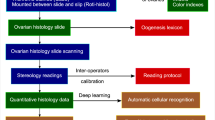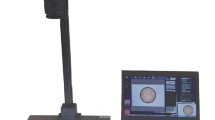Abstract
The assessment of the gametogenic cycle and gonadal stage in commercial species relevant for shellfisheries and aquaculture is essential for the optimal management of the resource. However, currently this assessment frequently relies on the subjective classification of the specimens into discrete stages of development, with a strong dependence on the observer. The present study developed a quantitative, continuous, and observer-independent method for the analysis of the gonadal stage of the edible sea urchin, Paracentrotus lividus. This new approach takes advantage of image analysis to assess in histological preparations of the gonads the cellular growth of germ cells and calculate a Pixelar index (PI). The PI can be calculated taking into account just the proportion of the area covered by germinal vs somatic cells in the gonad follicle (PI1) or computing also the empty space created in the follicle lumen after spawning (PI2), which reduces the variability of the index. In both cases, PI showed a bell-shaped dependence on the traditional gametogenic stage that could be fitted to a Gaussian model, providing a tool that can be used for the quantitative evaluation of effects on sea urchin gonads of any kind of environmental factors, from aquaculture rearing conditions to ecotoxicological effects of pollutants on wild stocks. Further assessment of intraindividual—both among gonads and within gonads—variability in this index will be necessary for refinement of this quantitative tool.



Similar content being viewed by others
References
Arcos FG, Ibarra AM, Rodríguez-Jaramillo MC, García-Latorre EA, Vazquez-Boucard C (2009) Quantification of vitellin/vitellogenin-like proteins in the oyster Crassostrea corteziensis (Hertlein 1951) as a tool to predict the degree of gonad maturity. Aquac Res 40(6):644–655. https://doi.org/10.1111/j.1365-2109.2008.02138.x
Arcos FG, Ibarra AM, Racotta LS (2011) Vitellogenin in hemolymph predicts gonad maturity in adult female Litopenaeus (Penaeus) vannamei shrimp. Aquaculture 316(1):93–98. https://doi.org/10.1016/j.aquaculture.2011.02.045
Beiras R, Durán I, Bellas J, Sánches-Marín P (2012) Biological effects of contaminants: Paracentrotus lividus sea urchin embryo test with marine sediment elutriates. ICES Techn Mar Environ Sci 51:13pp
Byrne M (1990) Annual reproductive cycles of the commercial sea urchin Paracentrotus lividus from an exposed intertidal and a sheltered subtidal habitat on the west coast of Ireland. Mar Biol 104(2):275–289. https://doi.org/10.1007/bf01313269
Carbonara S, D’Adamo R, Novelli A, Pelosi S, Fabbrocini A (2018) Ground Ulva solution (GUS): a promising metamorphosis cue for Paracentrotus lividus larviculture. Aquaculture 491:289–294. https://doi.org/10.1016/j.aquaculture.2018.03.044
Carpenter AE, Jones TR, Lamprecht MR, Clarke C, Kang IH, Friman O, Guertin DA, Chang JH, Lindquist RA, Moffat J, Golland P, Sabatini DM (2006) CellProfiler: image analysis software for identifying and quantifying cell phenotypes. Genome Biol 7(10):R100. https://doi.org/10.1186/gb-2006-7-10-r100
Castilla-Gavilán M, Buzin F, Cognie B, Dumay J, Turpin V, Decottignies P (2018) Optimising microalgae diets in sea urchin Paracentrotus lividus larviculture to promote aquaculture diversification. Aquaculture 490:251–259. https://doi.org/10.1016/j.aquaculture.2018.02.003
Crook AC (2003) Individual variation in the covering behaviour of the shallow water sea urchin Paracentrotus lividus. Mar Ecol 24(4):275–287. https://doi.org/10.1046/j.1439-0485.2003.00846.x
Delgado M, Pérez Camacho A (2003) A study of gonadal development in Ruditapes decussateu (L.) (Mollusca, Bivalvia), using image analysis techniques: influence of food ration and energy balance. J Shellfish Res 22(2):435–442
Dumont C, Pearce CM, Stazicker C, An YX, Keddy L (2006) Can photoperiod manipulation affect gonad development of a boreo-arctic echinoid (Strongylocentrotus droebachiensis) following exposure in the wild after the autumnal equinox? Mar Biol 149(2):365–378. https://doi.org/10.1007/s00227-005-0203-2
Fabbrocini A, D’Adamo R (2010) Gamete maturation and gonad growth in fed and starved sea urchin Paracentrotus lividus (Lamarck, 1816). J Shellfish Res 29(4):1051–1059. https://doi.org/10.2983/035.029.0407
Fabbrocini A, Maurizio D, D’Adamo R (2016) Sperm motility patterns as a tool for evaluating differences in sperm quality across gonad development stages in the sea urchin Paracentrotus lividus (Lmk, 1816). Aquaculture 452:115–119. https://doi.org/10.1016/j.aquaculture.2015.10.033
FAO (2016) Global aquaculture production 1950–2016. Fisheries and Aquaculture Department. http://www.fao.org/fishery/statistics/global-aquaculture-production/en. 2018
Fuji A (1960) Studies On The Biology Of The Sea Urchin: I. Superficial and histological gonadal changes in gametogenic process of two sea urchins, Strongylocentrotus nudus and S. intermedius. 北海道大學水産學部研究彙報= BULLETIN OF THE FACULTY OF FISHERIES HOKKAIDO UNIVERSITY 11 (1):1–14
Garmendia JM, Menchaca I, Belzunce MJ, Franco J, Revilla M (2010) Seasonal variability in gonad development in the sea urchin (Paracentrotus lividus) on the Basque coast (southeastern Bay of Biscay). Mar Pollut Bull 61(4):259–266. https://doi.org/10.1016/j.marpolbul.2010.02.023
Garrido CL, Barber BJ (2001) Effects of temperature and food ration on gonad growth and oogenesis of the green sea urchin, Strongylocentrotus droebachiensis. Mar Biol 138(3):447–456. https://doi.org/10.1007/s002270000473
Ghisaura S, Loi B, Biosa G, Baroli M, Pagnozzi D, Roggio T, Uzzau S, Anedda R, Addis MF (2016) Proteomic changes occurring along gonad maturation in the edible sea urchin Paracentrotus lividus. J Proteome 144:63–72. https://doi.org/10.1016/j.jprot.2016.05.035
Gianguzza P, Badalamenti F, Gianguzza F, Bonaviri C, Riggio S (2009) The operational sex ratio of the sea urchin Paracentrotus lividus populations: the case of the Mediterranean marine protected area of Ustica Island (Tyrrhenian Sea, Italy). Mar Ecol 30(1):125–132. https://doi.org/10.1111/j.1439-0485.2008.00267.x
Giraldo A, Montes R, Rodil R, Quintana JB, Vidal-Liñán L, Beiras R (2017) Ecotoxicological evaluation of the UV filters ethylhexyl dimethyl p-aminobenzoic acid and octocrylene using marine organisms Isochrysis galbana, Mytilus galloprovincialis and Paracentrotus lividus. Arch Environ Contam Toxicol 72(4):606–611. https://doi.org/10.1007/s00244-017-0399-4
Gómez-Robles E, Saucedo PE (2009) Evaluation of quality indices of the gonad and somatic tissues involved in reproduction of the pearl oyster Pinctada mazatlanica with histochemistry and digital image analysis. J Shellfish Res 28(2):329–335. https://doi.org/10.2983/035.028.0215
Gray E, Mitchell E, Jindal S, Schedin P, Chang YH (2018) A method for quantification of calponin expression in myoepithelial cells in immunohistochemical images of ductal carcinoma in situ. In: 2018 IEEE 15th International Symposium on Biomedical Imaging (ISBI 2018), 4–7 April 2018, pp 796–799. https://doi.org/10.1109/ISBI.2018.8363692
Hammer H, Hammer B, Watts S, Lawrence A, Lawrence J (2006) The effect of dietary protein and carbohydrate concentration on the biochemical composition and gametogenic condition of the sea urchin Lytechinus variegatus. J Exp Mar Biol Ecol 334(1):109–121. https://doi.org/10.1016/j.jembe.2006.01.015
Harrington LH, Walker CW, Lesser MP (2007) Stereological analysis of nutritive phagocytes and gametogenic cells during the annual reproductive cycle of the green sea urchin, Strongylocentrotus droebachiensis. Invertebr Biol 126(2):202–209. https://doi.org/10.1111/j.1744-7410.2007.00090.x
Heffernan PB, Walker RL (1989) Quantitative image analysis methods for use in histological studies of bivalve reproduction. J Molluscan Stud 55(1):135–137. https://doi.org/10.1093/mollus/55.1.135
Holland ND (1967) Gametogenesis during the annual reproductive cycle in a cidaroid sea urchin (Stylocidaris affinis). Biol Bull 133(3):578–590. https://doi.org/10.2307/1539919
Holland ND, Holland LZ (1969) Annual cycles in germinal and non-germinal cell populations in the gonads of the sea urchin Psammechinus microtuberculatus. Pubbl Staz Zool Napoli 37:394–404
Kainz P, Mayrhofer-Reinhartshuber M, Ahammer H (2015) IQM: an extensible and portable open source application for image and signal analysis in Java. PLoS One 10(1):e0116329. https://doi.org/10.1371/journal.pone.0116329
Kang D-H, Ahn I-Y, Choi K-S (2003) Quantitative assessment of reproductive condition of the Antarctic clam, Laternula elliptica (King & Broderip), using image analysis. Invertebrate Reproduction & Development 44(1):71–78. https://doi.org/10.1080/07924259.2003.9652555
Krishnakumar PK, Casillas E, Varanasi U (1994) Effect of environmental contaminants on the health of Mytilus edulis from Puget Sound, Washington, USA. I Cytochemical measures of lysosomal responses in the digestive cells using automatic image analysis. Marine Ecology Progress Series 106(3):249–261
Lamprecht MR, Sabatini DM, Carpenter AE (2007) CellProfiler™: free, versatile software for automated biological image analysis. BioTechniques 42(1):71–75. https://doi.org/10.2144/000112257
Laruelle F, Guillou J, Paulet YM (2009) Reproductive pattern of the clams, Ruditapes decussatus and R philippinarum on intertidal flats in Brittany. Journal of the Marine Biological Association of the United Kingdom 74(2):351–366. https://doi.org/10.1017/S0025315400039382
Lawless C, Wilkinson DJ, Young A, Addinall SG, Lydall DA (2010) Colonyzer: automated quantification of micro-organism growth characteristics on solid agar. BMC Bioinformatics 11(1):287. https://doi.org/10.1186/1471-2105-11-287
Lozano J, Galera J, López S, Turon X, Palacín C (1995) Biological cycles and recruitment of Paracentrotus lividus (Echinodermata: Echinoidea) in two contrasting habitats. Mar Ecol Prog Ser 122:179–191
Ouréns R, Fernández L, Fernández-Boán M, Naya I, Freire J (2013) Reproductive dynamics of the sea urchin Paracentrotus lividus on the Galicia coast (NW Spain): effects of habitat and population density. Mar Biol 160(9):2413–2423. https://doi.org/10.1007/s00227-013-2236-2
Paredes E, Bellas J, Costas D (2015) Sea urchin (Paracentrotus lividus) larval rearing — culture from cryopreserved embryos. Aquaculture 437:366–369. https://doi.org/10.1016/j.aquaculture.2014.12.022
Pazos AJ, Román G, Acosta CP, Abad M, Sánchez J (1996) Stereological studies on the gametogenic cycle of the scallop, Pecten maximus, in suspended culture in Ria de Arousa (Galicia, NW Spain). Aquaculture 142(1):119–135. https://doi.org/10.1016/0044-8486(95)01247-8
Ramofafia C, Battaglene SC, Bell JD, Byrne M (2000) Reproductive biology of the commercial sea cucumber Holothuria fuscogilva in the Solomon Islands. Mar Biol 136(6):1045–1056. https://doi.org/10.1007/s002270000310
Ruifrok AC, Johnston DA (2001) Quantification of histochemical staining by color deconvolution. Anal Quant Cytol Histol 23(4):291–299
Sartori D, Pellegrini D, Macchia S, Gaion A (2016) Can echinoculture be a feasible and effective activity? Analysis of fast reliable breeding conditions to promote gonadal growth and sexual maturation in Paracentrotus lividus. Aquaculture 451:39–46. https://doi.org/10.1016/j.aquaculture.2015.08.037
Schindelin J, Arganda-Carreras I, Frise E, Kaynig V, Longair M, Pietzsch T, Preibisch S, Rueden C, Saalfeld S, Schmid B, Tinevez J-Y, White DJ, Hartenstein V, Eliceiri K, Tomancak P, Cardona A (2012) Fiji: an open-source platform for biological-image analysis. Nat Methods 9:676. https://doi.org/10.1038/nmeth.2019
Selinummi J, Seppala J, Yli-Harja O, Puhakka JA (2005) Software for quantification of labeled bacteria from digital microscope images by automated image analysis. Biotechniques 39(6):859–863. https://doi.org/10.2144/000112018
Shaw BL, Battle HI (1957) The gross and microscopic anatomy of the digestive tract of the oyster Crassostrea virginica (Gmelin). Can J Zool 35(3):325–347. https://doi.org/10.1139/z57-026
Stoumboudi MT, Villwock W, Sela J, Abraham M (1993) Gonadosomatic index in Barbus longiceps, Capoeta damascina and their natural hybrid (Pisces, Cyprinidae), versus spermatozoan index in the parental males. J Fish Biol 43(6):865–875. https://doi.org/10.1111/j.1095-8649.1993.tb01161.x
Thorsen A, Kjesbu OS (2001) A rapid method for estimation of oocyte size and potential fecundity in Atlantic cod using a computer-aided particle analysis system. J Sea Res 46(3):295–308. https://doi.org/10.1016/S1385-1101(01)00090-9
Unuma T, Walker CW (2010) The role of the major yolk protein in sea urchin reproduction and its relevance to aquaculture. In: Harris LG, Böttger SA, Walker CW, Lesser MP (eds) Echinoderms. Durham. CRC Press, Taylor and Francis Group, Balkema, the Netherlands, pp 437–444
Walker CW, Lesser MP, Unuma T (2013) Sea urchin gametogenesis – structural, functional and molecular/genomic biology. In: John ML (ed) Sea urchins: biology and ecology, vol Volume 38. vol Developments in Aquaculture and Fisheries Science. Elsevier, pp 25-43. doi:https://doi.org/10.1016/B978-0-12-396491-5.00003-4
Wiesmann V, Franz D, Held C, Münzenmayer C, Palmisano R, Wittenberg T (2015) Review of free software tools for image analysis of fluorescence cell micrographs. J Microsc 257(1):39–53. https://doi.org/10.1111/jmi.12184
Acknowledgements
The authors are grateful for the level of technical assistance from all the staff of ECIMAT and in particular Dr. Estefania Paredes-Rosendo who kindly shared some histological preparations.
Funding
This research was supported by MINECO (Research Projects PCIN-2015-187-C03-03 and CTM2016-77945-C3-1-R) and Xunta de Galicia (FEDER-GALICIA 2014-20 DOG31).
Author information
Authors and Affiliations
Corresponding author
Ethics declarations
Conflict of interest
The authors declare that they have no conflict of interest.
Ethical approval
All experiments were carried out according to ECIMAT and the European Directive 2010/63/EU for experiments, care, and use of animals.
Additional information
Publisher’s note
Springer Nature remains neutral with regard to jurisdictional claims in published maps and institutional affiliations.
Rights and permissions
About this article
Cite this article
Mantilla-Aldana, L., Campoy-López, P., Pereira-Pinto, E. et al. Pixelar index: a new quantitative approach for the assessment of reproductive condition in the purple sea urchin, Paracentrotus lividus, by image analysis. Aquacult Int 28, 841–850 (2020). https://doi.org/10.1007/s10499-019-00499-8
Received:
Accepted:
Published:
Issue Date:
DOI: https://doi.org/10.1007/s10499-019-00499-8




